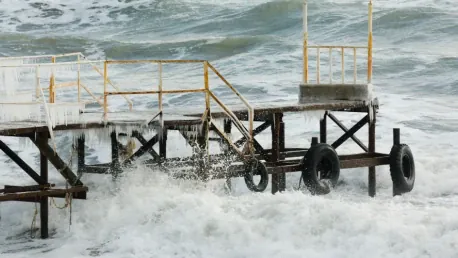Tropical Cyclone Seedling 96S has wreaked havoc on the island paradise of Bali, bringing with it extreme weather conditions that have significantly impacted both tourist activities and public safety. High winds and relentless rainfall have battered the island, causing disruptions and prompting updated weather advisories from BMKG Bali. These advisories, initially effective until at least February 12th, may be extended as the cyclone continues to linger south of East Nusa Tenggara in the Indian Ocean. The extent of its impact has been felt not just in Bali but also in neighboring areas like Lombok and the Gili Islands.
Impact on Weather and Safety
Adverse Weather Conditions
The cyclone’s influence on Bali’s weather has been profound, with its effects felt most heavily in the southern parts of the island. While Bali is still within its rainy season, the presence of Tropical Cyclone Seedling 96S has exacerbated conditions, leading to heightened wind speeds and dangerous sea wave heights. Wind speeds reaching up to 74 km/h have been recorded, significantly increasing the potential for hazards related to outdoor activities and travel. Meanwhile, sea wave heights have reached between 2.5 to 3.5 meters, posing a serious threat to any maritime ventures in the region.
The Bali Meteorology, Climatology, and Geophysical Agency (BMKG) has emphasized the dangerous combination of high winds and heavy rainfall, which has already caused several incidents, including landslides and falling trees. The agency has urged both tourists and residents to exercise heightened caution, particularly in southern Bali where beach activities should be minimized due to rough seas. Motorcyclists, a common sight on Bali’s roads, have also been advised to stay alert and avoid traveling during severe weather to prevent accidents.
BMKG Bali’s Weather Advisories
BMKG Bali’s updated weather advisories have been essential in keeping the public informed of the developing situation. These advisories highlight the ongoing risks posed by the cyclone and offer crucial guidance for staying safe during its passage. The agency’s advisories underscore the importance of staying updated with the latest weather forecasts, available on their Instagram and other communication channels. Tourists, in particular, should closely monitor these updates to adjust their plans accordingly and avoid hazardous situations.
The advisories also include specific recommendations for residents and visitors to remain indoors whenever possible, secure potential loose objects around their homes that could become projectiles in high winds, and avoid areas prone to landslides or flooding. BMKG has also been coordinating with local authorities to implement emergency response measures and provide timely information to the public, ensuring a concerted effort in mitigating the cyclone’s adverse effects.
Response and Mitigation Efforts
Bali Regional Disaster Management Agency Initiatives
In response to the cyclone’s impact, the Bali Regional Disaster Management Agency (BPBD) has been actively managing the consequences of natural disaster incidents resulting from the storm. Their initiatives focus primarily on addressing emergency situations, such as clearing fallen trees and managing landslides, which have already resulted in three fatalities and six injuries. Property damage from these incidents is estimated to be around IDR 515 million, showcasing the cyclone’s devastating effect on the region’s infrastructure.
BPBD’s ongoing mitigation efforts stress the importance of public vigilance and preparedness during these challenging conditions. The agency has been working tirelessly to ensure that residents and tourists are informed of the risks and know how to stay safe. Emergency response teams are on high alert and ready to assist with search and rescue operations if necessary. Additionally, BPBD has been coordinating with other government agencies to bolster its efforts, ensuring that resources are allocated efficiently and all possible precautions are taken.
Advisories for Tourists and Residents
Tourists visiting Bali during this turbulent period have been given specific advice to stay out of harm’s way. Staying updated on weather forecasts via BMKG Bali’s Instagram is crucial for making informed decisions about travel and outdoor activities. The heavy winds pose a particular danger for motorcyclists, who should take extra care or avoid traveling altogether during severe weather conditions.
For those intending to visit outlying islands or use ferry services, it is essential to anticipate potential cancellations or delays due to the high winds and rough seas. Tour operators and transportation services are on high alert and may adjust schedules or halt services to ensure the safety of passengers. Visitors to the renowned southern Bali beaches have also been warned that swimming and other water activities should be avoided until conditions stabilize.
Collectively, these advisories and safety measures highlight the importance of vigilance and careful planning during extreme weather events. The continuous monitoring and mitigation efforts by government agencies underscore the vital role of public cooperation in maintaining safety. As the cyclone’s impacts continue to affect the region, staying informed and adhering to safety advisories remain paramount for both residents and tourists.
Future Considerations and Preparedness
Long-Term Safety Measures
Considering the unpredictable nature of tropical cyclones, long-term safety measures and preparedness are crucial. The recent events underscore the need for continued investment in infrastructure that can withstand such extreme conditions. Strengthening the island’s emergency response capabilities, improving communication channels, and enhancing public awareness campaigns are vital components in minimizing future risks. Collaborative efforts between local authorities, tourism operators, and residents will be essential in ensuring that Bali remains resilient in the face of natural disasters.
Community and Tourism Sector Involvement
Tropical Cyclone Seedling 96S has caused chaos on the serene island of Bali, triggering severe weather that has deeply affected both tourism and public safety. The island has endured strong winds and nonstop rainfall, leading to significant disruptions and necessitating new weather advisories from BMKG Bali. Initially set to last until at least February 12th, these advisories may be extended as the cyclone hovers south of East Nusa Tenggara in the Indian Ocean. The cyclone’s impact isn’t confined to Bali; it has also affected nearby regions such as Lombok and the Gili Islands. Tourists and locals alike are experiencing the harsh conditions, with travel plans being upended and daily routines disrupted due to the severe weather. Emergency services are on high alert to assist those affected, and authorities are urging caution and preparedness. The unpredictability of the cyclone’s path means that the weather situation could change rapidly, warranting close monitoring and adherence to official updates.









